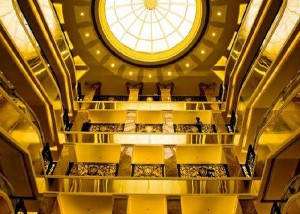
Vietnam’s retail market is predicted to improve this year because of stability in the economy, greater consumer confidence, lower oil prices and lower interest rates – all of which should lead to greater spending.
Richard Leech Executive Director of CBRE Vietnam, noted that retail sales and services at the end of 2014 grew to approx. US$140 billion, however growth had slowed significantly over the last few years.
The supply of retail space has grown in both the major markets of Hanoi and HCMC, and will continue to grow during 2015, according to CBRE. By the end of the year, it is expected that Hanoi will have approx. 900,000 sqm of formal retail space and HCMC 600,000 sqm.
In terms of the number of projects and square meters in the pipeline Hanoi and HCMC stack up well against its regional neighbours with Hanoi in 7th position. Most other cities ahead of Hanoi are in China. HCMC is expecting at least five new projects in 2015, two of which are being developed by SSG, a megamall project by Vingroup and the eagerly awaited Vivo City due to open in D7 in April 2015.
Apart from having more supply of formal retail space than HCMC, Hanoi has softer rents and higher vacancies. HCMC rental have remained stable at approximately US$100 per sqm in the central business district and approximately US$40 per sqm in the non-CBD locations. HCMC vacancies are less than 8 percent compared with Hanoi of more than 20 percent.
New supply in 2014 was dominated by Lotte in the North and by Aeon in the South. Both these retail giants, from South Korea and Japan respectively, opened in multiple locations in Vietnam and will continue to expand into 2015.
Leech noted that the Metro Line number one, currently under construction, will link several shopping centre’s in the HCMC’s central business district and District 2.
“With the completion of The One, Saigon Centre Phase 2 and the Tax Plaza in District 1, HCMC shoppers can anticipate a shopping district on a par with Sukhumvit Road in Bangkok or the famous Orchard Road in Singapore,” he explained.
The development of new shoppings centre’s has resulted in an influx of new tenants to Vietnam. In 2014 Hanoi saw 27 new brands names come to new developments such as the refurbished Trang Tien Plaza and the Royal City Megamall in Da Dong District. New brands to the HCMC retail scene in 2014 included Robins Department Store, Lalique and Marks and Spencers.
Apart from the aggressive expansion plans for foreign and local retailers in Vietnam in 2015, one of the most noticeable trends is ‘affordability’. The emergence of new bazaars, containing hundreds of small kiosks, rent free shopping malls such as Hoa Binh Green City, and low price supermarkets are all reinforcing the trend that consumers demand better value for money.
Food and beverage outlets have been the stand out sector during 2014 and will continue to dominate the high streets.
CBRE explained that nearly 50 percent of its enquiries for retail space where in this sector and that the enquiries were more likely to be for fast casual dining rather than high end dining.
“The F&B sector is leading the charge in terms of occupying ‘unconventional’ retail space, and grouping together in specific nodes such as West Lake in Hanoi and Crescent Lake in HCMC” explained Leech.
Competition for a share of the consumers’ wallet is fierce. Consumers are now more sophisticated and knowledgeable and place value on an overall retail experience when shopping, Leech added.
Shopping centre managers will need to have a good understanding of what their customers want, leverage the data they can collect from aps and digital marketing, provide more and better quality entertainment facilities and collaborate more with retailers.
Andrew Batt, International Group Editor of PropertyGuru Group, wrote this story. To contact him about this or other stories email andrew@propertyguru.com.sg
Related Articles:
Frasers Centrepoint unveils office building in Cecil Street
CapitaCommercial subsidiary to issue S$98.48mil notes
CIT to acquire Gul Circle property for S$16.2m
